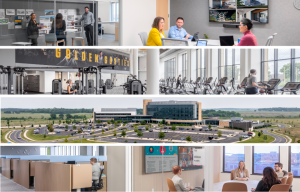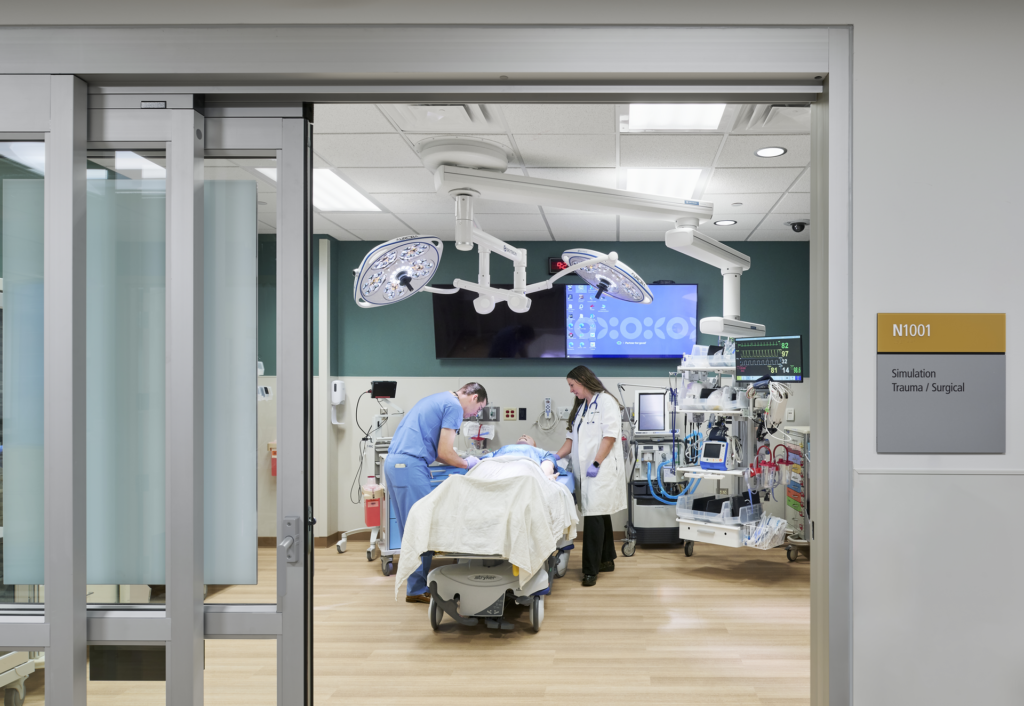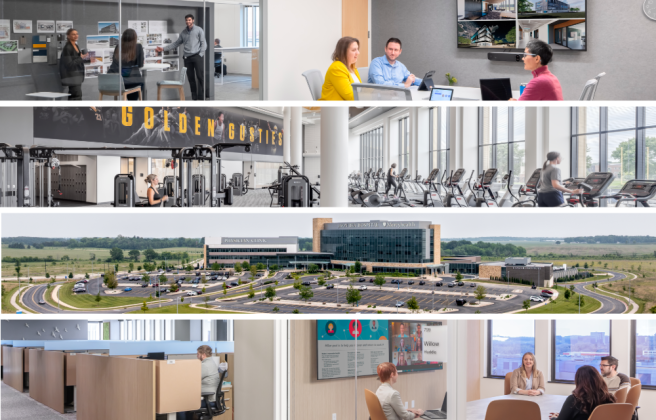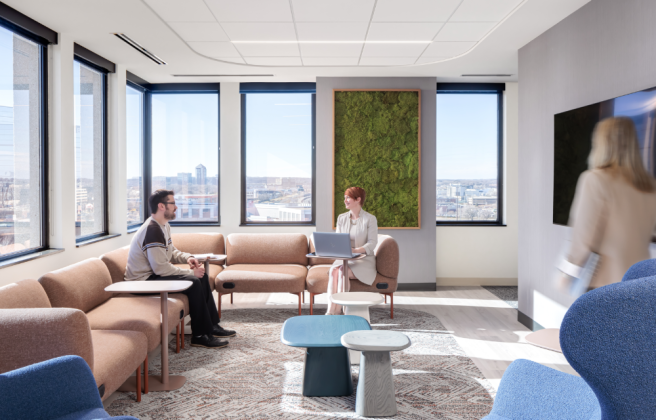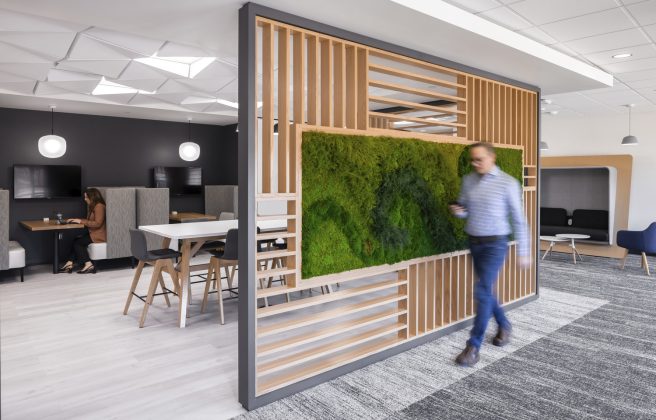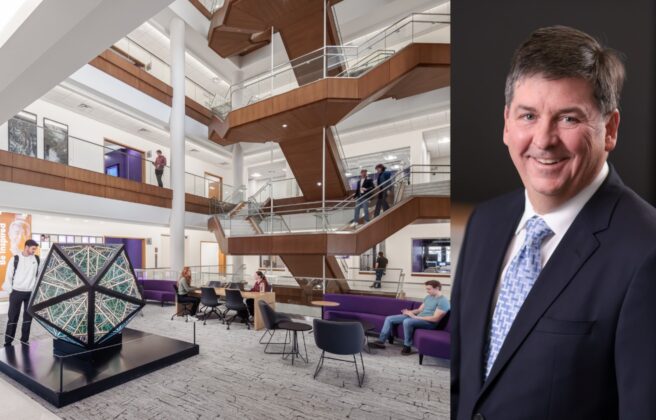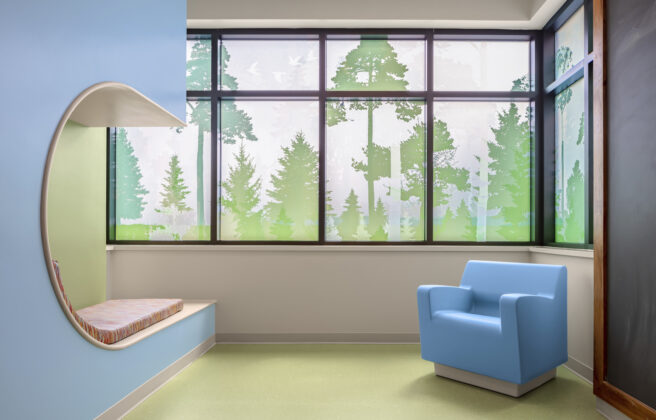Simulation spaces are high-tech, realistic environments designed to train both students preparing for careers in healthcare and medical professionals learning new skills. These environments require both the functionality of real healthcare spaces and classroom elements for teaching and learning, allowing users to practice skills, learn new procedures, or explore techniques that will be applied in real hospital settings.
In the latest episode of Side of Design from BWBR, guest host and Project Manager Jarett Anderson opens the door to the exciting realm of simulation spaces. Joined by BWBR Principal Leigh Streit, Senior Planner Rich Dunham, and Senior Project Manager Brian Lapham, the discussion delves into the unique functionalities, design considerations, and emerging trends in these innovative facilities.
Simulation Spaces in Action
Simulation spaces encompass a broad spectrum of environments, from OR and delivery rooms, to the back of an ambulance for EMS training, and even residential spaces for occupational therapy and home health. Some colleges and universities require interdisciplinary environments that can simulate a range of healthcare settings to meet the needs of nursing programs.
Large public universities, small private institutions, and community or technical colleges all have varying program offerings and sizes, which means the design approach must be uniquely tailored to each simulation project. In one recent example, the team partnered with a small private school that was working to build a brand-new nursing program from the ground up – a very different design strategy than a large institution with an established nursing school would require.
“There was a lot of programming, figuring out how much space do you need? What is your cohort size? How can you grow into this space? And then a couple of years later, you can plan to design and build phase two,” Brian explains.
No matter the size or type of simulation environment, each of these spaces serve as valuable tools for learning, process improvement, and error reduction. “These simulation labs are practically driven to create a setting that gives trainees this ability to perfect their art,” says Rich.
Blending Healthcare and Education
One key consideration in designing simulation spaces is the required level of realism. This can range from high-tech mannequins that record real-time procedural steps to simple models that create space for plenty of imagination. In these projects, BWBR’s experience in both healthcare and education design comes together to accurately recreate real-world environments with the necessary modalities for learning.
“We’ve borrowed planners from our healthcare practice to make sure that when we’re going to invest in a new OR simulation space, that we’re getting the most current idea, understanding, design, and planning of the healthcare world brought over to the educational side,” Leigh says. “We start from a lot of fundamental healthcare building blocks.”
Flexibility is another critical factor because leading-edge environments like simulation spaces must adapt to a variety of different scenarios and future needs. For example, Rich shared a recent design that could flex to become a classroom, a small gathering space, and a treatment space.
Every Detail Counts
While simulation rooms often take center stage, “we’d be remiss if we go without talking about storage and other support spaces,” Leigh emphasizes. From storage for mannequins and equipment to spaces for patient actors to change and enter discreetly, these behind-the-scenes areas are vital to the smooth operation of simulation facilities.
Both storage and support areas also play a part in allowing for the flexibility often required – “You can have a series of headwalls, you can have movable panels, you can have a lot of things in that space that let it do more than just one job. And that happens with storage and how that scene gets changed and what tools come in there and how it gets used,” Jarett explains.
Every detail counts when it comes to optimizing workflows and future-proofing spaces with adaptable elements – after all, these simulation spaces are the backdrop for training that will lead to life-altering, life-saving work. As Brian emphasizes, “Everybody will interact with nurses and healthcare professionals at some point in their life, and we want them to be fantastic and know how to do their work and do it well.”
The Future of Simulation Spaces
As technology advances, so do the possibilities for simulation spaces. Virtual reality is increasingly being explored, and there’s a lot of excitement around it. Leigh acknowledges that the economics of VR are a barrier, but that VR capability is “inherently pretty flexible,” which may improve ROI and make VR investments more accessible, especially as technology advances.
We’re also likely to see more simulation spaces used to support medical device development in the future. Brian tells of simulation environments where “you can place your medical device into a virtual human, and then you can see it – almost like the old children’s books, The Magic School Bus, where you jump into the body, and you can zoom around and see, ‘Oh, we should rotate this device a little bit.’”
Ultimately, the future of simulation spaces will be shaped by the unique needs and priorities of each institution. Rich is excited to watch medical training facilities leverage different setups in “the perfection of their medical arts,” as he puts it – and, of course, great design makes that possible.

